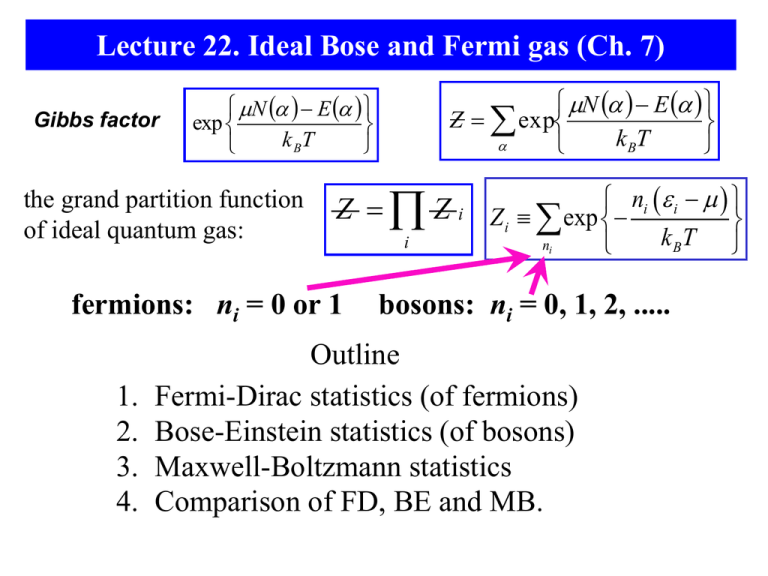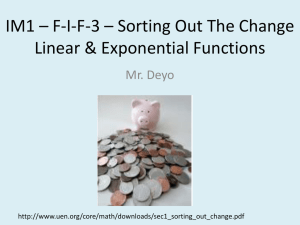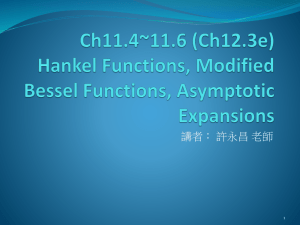Ideal Bose and Fermi Gas: Statistics & Distributions
advertisement

Lecture 22. Ideal Bose and Fermi gas (Ch. 7) Gibbs factor the grand partition function of ideal quantum gas: Z Z i Zi exp ni i fermions: ni = 0 or 1 1. 2. 3. 4. N E Z exp k BT N E exp k T B i ni kBT bosons: ni = 0, 1, 2, ..... Outline Fermi-Dirac statistics (of fermions) Bose-Einstein statistics (of bosons) Maxwell-Boltzmann statistics Comparison of FD, BE and MB. The Partition Function of an Ideal Fermi Gas The grand partition function for all particles in the ith single-particle state (the sum is taken over all possible values of ni) : ni i Z i exp ni k BT i 1 exp k BT If the particles are fermions, n can only be 0 or 1: Z Putting all the levels together, the full partition function is given by: i 1 exp i k BT Z FD FD i Fermi-Dirac Distribution The probability of a state to be occupied by a fermion: ni i 1 P i , ni exp ni 0, 1 Zi k BT The mean number of fermions in a particular state: 1 1 ni Zi 1 exp i Zi 1 exp i exp i 1 exp i 1 exp i 1 Fermi-Dirac distribution ( is determined by T and the particle density) 1 nFD 1 exp k BT Fermi-Dirac Distribution At T = 0, all the states with < have the occupancy = 1, all the states with > have the occupancy = 0 (i.e., they are unoccupied). With increasing T, the step-like function is “smeared” over the energy range ~ kBT. 1 ~ kBT 0 T=0 (with respect to ) = The macrostate of such system is completely defined if we know the mean occupancy for all energy levels, which is often called the distribution function: f E n E While f(E) is often less than unity, it is not a probability: f E n i n=N/V – the average density of particles The Partition Function of an Ideal Bose Gas The grand partition function for all particles in the ith single-particle state (the sum is taken over all possible values of ni) : ni i Zi exp k T ni B If the particles are Bosons, n can be any #, i.e. 0, 1, 2, … ni i i 2 i Zi exp 1 exp exp ni 0 k BT k BT k BT 2 If x 1, 1 x x 1 1 x Zi BE i 1 exp k BT Putting all the levels i together, the full partition Z BE 1 exp i k BT function is given by: 1 1 min i Bose-Einstein Distribution The probability of a state to be occupied by a Boson: ni i 1 P i , ni exp ni 0,1,2, Zi k BT The mean number of Bosons in a particular state: 1 i 1 ni Zi 1 exp 1 exp i Zi k BT i 1 exp kBT exp i 1 exp i Bose-Einstein distribution 2 1 exp i 1 min The mean number of particles in a 1 nBE given state for the BEG can exceed exp 1 unity, it diverges as min(). k BT Comparison of FD and BE Distributions 2 1 nFD 1 exp k BT <n> BE 1 FD nBE n n 0 -6 when -4 k BT -2 0 2 ()/kBT 1, exp k T B Maxwell-Boltzmann distribution: 4 1 6 1 exp 1 k BT nFD nBE nMB 1 exp k T B 1 exp k T B Maxwell-Boltzmann Distribution (ideal gas model) Recall the Boltzmann distribution (ch.6) derived from canonical ensemble: 2 mk B T Z1 V 2 h 3/ 2 V VQ V 1 N Z Z1 F k BT ln Z Nk BT ln N! NVQ V F k BT ln N T ,V NVQ 1 N N ln exp Z1 Z1 1 The mean number of particles in a particular state of N particles in volume V: nMB N P N exp exp exp exp Z1 nMB exp MB is the low density limit where the k T B difference between FD and BE disappears. Maxwell-Boltzmann distribution nVQ 1 i.e. N Z1 1 and 0 nVQ 1 Comparison of FD, BE and MB Distribution 2 <n> MB 1 nFD 1 exp k BT BE 1 1 nBE exp 1 k BT FD n n 0 -6 -4 -2 0 2 ()/kBT 4 6 nMB exp k T B what are the possible values of MB , FD , and BE ? assume 0 MB 0 FD F 0 BE min 0 Comparison of FD, BE and MB Distribution (at low density limit) <n> 1.0 = - kBT The difference between FD, BE and MB gets smaller when gets more negative. MB FD BE 0.5 i.e., when 0.0 0 1 /kBT 2 3 MB is the low density limit where the difference between FD and BE disappears. 0.2 MB FD BE <n> = - 2kBT 0.1 nVQ 0.0 0 1 2 /kBT 0, nFD nBE nMB 3 1 i.e. N Z1 1 Comparison between Distributions Boltzmann nk 1 exp k BT Bose Einstein nk 1 1 exp k BT Fermi Dirac nk 1 1 exp k BT indistinguishable Z=(Z1)N/N! nK<<1 indistinguishable integer spin 0,1,2 … indistinguishable half-integer spin 1/2,3/2,5/2 … spin doesn’t matter bosons fermions localized particles don’t overlap wavefunctions overlap total symmetric wavefunctions overlap total anti-symmetric photons atoms free electrons in metals electrons in white dwarfs unlimited number of particles per state never more than 1 particle per state gas molecules at low densities “unlimited” number of particles per state nK<<1 4He “The Course Summary” Ensemble Macrostate microcanonical U, V, N (T fluctuates) canonical T, V, N (U fluctuates) grand canonical Probability Pn The grand potential S U ,V , N kB ln 1 En 1 kB T Pn e Z 1 T, V, Pn e (N, U fluctuate) Z k BT ln Z Thermodynamics En N n kB T F T ,V , N kB T ln Z T ,V , kB T ln Z (the Landau free energy) is a generalization of F=-kBT lnZ - the appearance of μ as a variable, while d SdT PdV Nd computationally very convenient for the grand canonical ensemble, is not natural. Thermodynamic properties of systems are eventually measured with a given density of particles. However, in the grand canonical ensemble, quantities like pressure or N are given as functions of the “natural” variables T,V and μ. Thus, we need to use in terms of T and n=N/V. / T ,V N to eliminate μ









